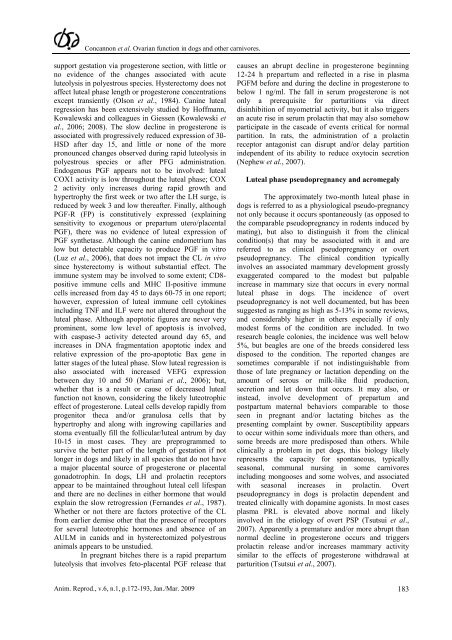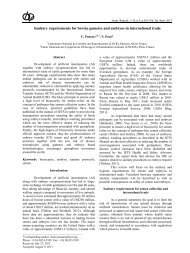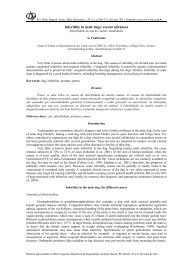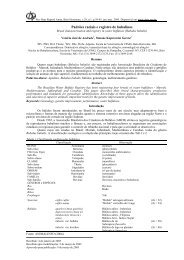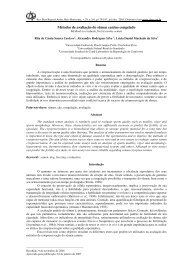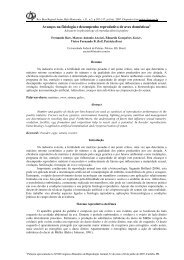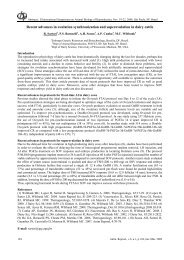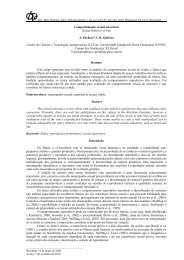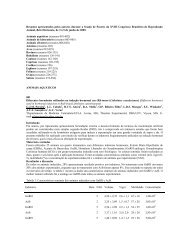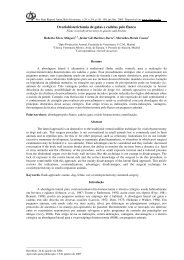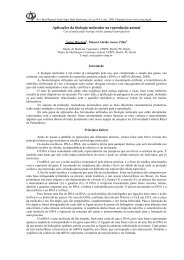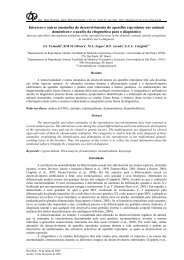Endocrine control of ovarian function in dogs and other carnivores
Endocrine control of ovarian function in dogs and other carnivores
Endocrine control of ovarian function in dogs and other carnivores
Create successful ePaper yourself
Turn your PDF publications into a flip-book with our unique Google optimized e-Paper software.
Concannon et al. Ovarian <strong>function</strong> <strong>in</strong> <strong>dogs</strong> <strong>and</strong> <strong>other</strong> <strong>carnivores</strong>.<br />
support gestation via progesterone section, with little or<br />
no evidence <strong>of</strong> the changes associated with acute<br />
luteolysis <strong>in</strong> polyestrous species. Hysterectomy does not<br />
affect luteal phase length or progesterone concentrations<br />
except transiently (Olson et al., 1984). Can<strong>in</strong>e luteal<br />
regression has been extensively studied by H<strong>of</strong>fmann,<br />
Kowalewski <strong>and</strong> colleagues <strong>in</strong> Giessen (Kowalewski et<br />
al., 2006; 2008). The slow decl<strong>in</strong>e <strong>in</strong> progesterone is<br />
associated with progressively reduced expression <strong>of</strong> 3ß-<br />
HSD after day 15, <strong>and</strong> little or none <strong>of</strong> the more<br />
pronounced changes observed dur<strong>in</strong>g rapid luteolysis <strong>in</strong><br />
polyestrous species or after PFG adm<strong>in</strong>istration.<br />
Endogenous PGF appears not to be <strong>in</strong>volved: luteal<br />
COX1 activity is low throughout the luteal phase; COX<br />
2 activity only <strong>in</strong>creases dur<strong>in</strong>g rapid growth <strong>and</strong><br />
hypertrophy the first week or two after the LH surge, is<br />
reduced by week 3 <strong>and</strong> low thereafter. F<strong>in</strong>ally, although<br />
PGF-R (FP) is constitutively expressed (expla<strong>in</strong><strong>in</strong>g<br />
sensitivity to exogenous or prepartum utero/placental<br />
PGF), there was no evidence <strong>of</strong> luteal expression <strong>of</strong><br />
PGF synthetase. Although the can<strong>in</strong>e endometrium has<br />
low but detectable capacity to produce PGF <strong>in</strong> vitro<br />
(Luz et al., 2006), that does not impact the CL <strong>in</strong> vivo<br />
s<strong>in</strong>ce hysterectomy is without substantial effect. The<br />
immune system may be <strong>in</strong>volved to some extent; CD8positive<br />
immune cells <strong>and</strong> MHC II-positive immune<br />
cells <strong>in</strong>creased from day 45 to days 60-75 <strong>in</strong> one report;<br />
however, expression <strong>of</strong> luteal immune cell cytok<strong>in</strong>es<br />
<strong>in</strong>clud<strong>in</strong>g TNF <strong>and</strong> ILF were not altered throughout the<br />
luteal phase. Although apoptotic figures are never very<br />
prom<strong>in</strong>ent, some low level <strong>of</strong> apoptosis is <strong>in</strong>volved,<br />
with caspase-3 activity detected around day 65, <strong>and</strong><br />
<strong>in</strong>creases <strong>in</strong> DNA fragmentation apoptotic <strong>in</strong>dex <strong>and</strong><br />
relative expression <strong>of</strong> the pro-apoptotic Bax gene <strong>in</strong><br />
latter stages <strong>of</strong> the luteal phase. Slow luteal regression is<br />
also associated with <strong>in</strong>creased VEFG expression<br />
between day 10 <strong>and</strong> 50 (Mariani et al., 2006); but,<br />
whether that is a result or cause <strong>of</strong> decreased luteal<br />
<strong>function</strong> not known, consider<strong>in</strong>g the likely luteotrophic<br />
effect <strong>of</strong> progesterone. Luteal cells develop rapidly from<br />
progenitor theca <strong>and</strong>/or granulosa cells that by<br />
hypertrophy <strong>and</strong> along with <strong>in</strong>grow<strong>in</strong>g capillaries <strong>and</strong><br />
stoma eventually fill the follicular/luteal antrum by day<br />
10-15 <strong>in</strong> most cases. They are preprogrammed to<br />
survive the better part <strong>of</strong> the length <strong>of</strong> gestation if not<br />
longer <strong>in</strong> <strong>dogs</strong> <strong>and</strong> likely <strong>in</strong> all species that do not have<br />
a major placental source <strong>of</strong> progesterone or placental<br />
gonadotroph<strong>in</strong>. In <strong>dogs</strong>, LH <strong>and</strong> prolact<strong>in</strong> receptors<br />
appear to be ma<strong>in</strong>ta<strong>in</strong>ed throughout luteal cell lifespan<br />
<strong>and</strong> there are no decl<strong>in</strong>es <strong>in</strong> either hormone that would<br />
expla<strong>in</strong> the slow retrogression (Fern<strong>and</strong>es et al., 1987).<br />
Whether or not there are factors protective <strong>of</strong> the CL<br />
from earlier demise <strong>other</strong> that the presence <strong>of</strong> receptors<br />
for several luteotrophic hormones <strong>and</strong> absence <strong>of</strong> an<br />
AULM <strong>in</strong> canids <strong>and</strong> <strong>in</strong> hysterectomized polyestrous<br />
animals appears to be unstudied.<br />
In pregnant bitches there is a rapid prepartum<br />
luteolysis that <strong>in</strong>volves feto-placental PGF release that<br />
causes an abrupt decl<strong>in</strong>e <strong>in</strong> progesterone beg<strong>in</strong>n<strong>in</strong>g<br />
12-24 h prepartum <strong>and</strong> reflected <strong>in</strong> a rise <strong>in</strong> plasma<br />
PGFM before <strong>and</strong> dur<strong>in</strong>g the decl<strong>in</strong>e <strong>in</strong> progesterone to<br />
below 1 ng/ml. The fall <strong>in</strong> serum progesterone is not<br />
only a prerequisite for parturitions via direct<br />
dis<strong>in</strong>hibition <strong>of</strong> myometrial activity, but it also triggers<br />
an acute rise <strong>in</strong> serum prolact<strong>in</strong> that may also somehow<br />
participate <strong>in</strong> the cascade <strong>of</strong> events critical for normal<br />
partition. In rats, the adm<strong>in</strong>istration <strong>of</strong> a prolact<strong>in</strong><br />
receptor antagonist can disrupt <strong>and</strong>/or delay partition<br />
<strong>in</strong>dependent <strong>of</strong> its ability to reduce oxytoc<strong>in</strong> secretion<br />
(Nephew et al., 2007).<br />
Luteal phase pseudopregnancy <strong>and</strong> acromegaly<br />
The approximately two-month luteal phase <strong>in</strong><br />
<strong>dogs</strong> is referred to as a physiological pseudo-pregnancy<br />
not only because it occurs spontaneously (as opposed to<br />
the comparable pseudopregnancy <strong>in</strong> rodents <strong>in</strong>duced by<br />
mat<strong>in</strong>g), but also to dist<strong>in</strong>guish it from the cl<strong>in</strong>ical<br />
condition(s) that may be associated with it <strong>and</strong> are<br />
referred to as cl<strong>in</strong>ical pseudopregnancy or overt<br />
pseudopregnancy. The cl<strong>in</strong>ical condition typically<br />
<strong>in</strong>volves an associated mammary development grossly<br />
exaggerated compared to the modest but palpable<br />
<strong>in</strong>crease <strong>in</strong> mammary size that occurs <strong>in</strong> every normal<br />
luteal phase <strong>in</strong> <strong>dogs</strong>. The <strong>in</strong>cidence <strong>of</strong> overt<br />
pseudopregnancy is not well documented, but has been<br />
suggested as rang<strong>in</strong>g as high as 5-13% <strong>in</strong> some reviews,<br />
<strong>and</strong> considerably higher <strong>in</strong> <strong>other</strong>s especially if only<br />
modest forms <strong>of</strong> the condition are <strong>in</strong>cluded. In two<br />
research beagle colonies, the <strong>in</strong>cidence was well below<br />
5%, but beagles are one <strong>of</strong> the breeds considered less<br />
disposed to the condition. The reported changes are<br />
sometimes comparable if not <strong>in</strong>dist<strong>in</strong>guishable from<br />
those <strong>of</strong> late pregnancy or lactation depend<strong>in</strong>g on the<br />
amount <strong>of</strong> serous or milk-like fluid production,<br />
secretion <strong>and</strong> let down that occurs. It may also, or<br />
<strong>in</strong>stead, <strong>in</strong>volve development <strong>of</strong> prepartum <strong>and</strong><br />
postpartum maternal behaviors comparable to those<br />
seen <strong>in</strong> pregnant <strong>and</strong>/or lactat<strong>in</strong>g bitches as the<br />
present<strong>in</strong>g compla<strong>in</strong>t by owner. Susceptibility appears<br />
to occur with<strong>in</strong> some <strong>in</strong>dividuals more than <strong>other</strong>s, <strong>and</strong><br />
some breeds are more predisposed than <strong>other</strong>s. While<br />
cl<strong>in</strong>ically a problem <strong>in</strong> pet <strong>dogs</strong>, this biology likely<br />
represents the capacity for spontaneous, typically<br />
seasonal, communal nurs<strong>in</strong>g <strong>in</strong> some <strong>carnivores</strong><br />
<strong>in</strong>clud<strong>in</strong>g mongooses <strong>and</strong> some wolves, <strong>and</strong> associated<br />
with seasonal <strong>in</strong>creases <strong>in</strong> prolact<strong>in</strong>. Overt<br />
pseudopregnancy <strong>in</strong> <strong>dogs</strong> is prolact<strong>in</strong> dependent <strong>and</strong><br />
treated cl<strong>in</strong>ically with dopam<strong>in</strong>e agonists. In most cases<br />
plasma PRL is elevated above normal <strong>and</strong> likely<br />
<strong>in</strong>volved <strong>in</strong> the etiology <strong>of</strong> overt PSP (Tsutsui et al.,<br />
2007). Apparently a premature <strong>and</strong>/or more abrupt than<br />
normal decl<strong>in</strong>e <strong>in</strong> progesterone occurs <strong>and</strong> triggers<br />
prolact<strong>in</strong> release <strong>and</strong>/or <strong>in</strong>creases mammary activity<br />
similar to the effects <strong>of</strong> progesterone withdrawal at<br />
parturition (Tsutsui et al., 2007).<br />
Anim. Reprod., v.6, n.1, p.172-193, Jan./Mar. 2009 183


